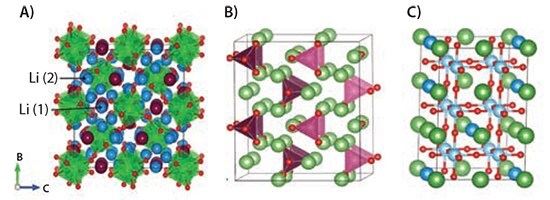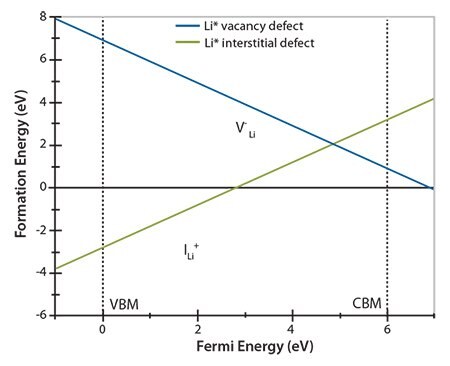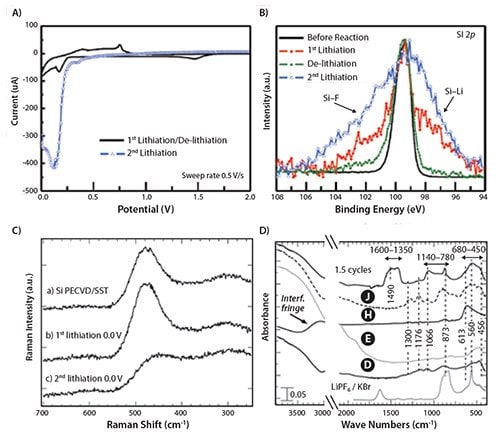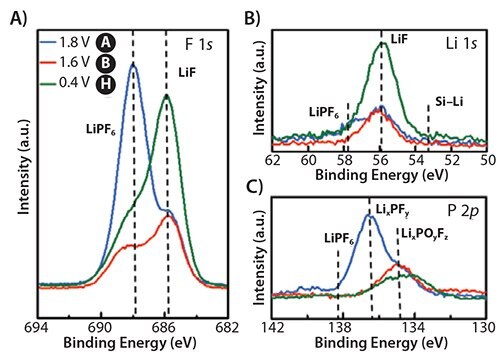Safer High-Performance Electrodes, Solid Electrolytes, and Interface Reactions for Lithium-Ion Batteries
Yves J. Chabal, Kyeongjae Cho, Christopher L. Hinkle, Roberto C. Longo, K. C. Santosh, Amandeep K. Sra, David E. Arreaga-Salas, Katy Roodenko
Department of Materials Science and Engineering, University of Texas at Dallas, Richardson, Texas 75082 USA
Introduction
Li-ion batteries are currently the focus of numerous research efforts with applications designed to reduce carbon-based emissions and improve energy storage capabilities.1,2 The potential for high energy density storage capacity makes Li-ion batteries extremely promising devices for large-scale implementation in hybrid or pure electric vehicles, and in energy storage of both solar and wind power.3,4 Li-ion batteries store chemical energy, delivering it in the form of electric power with high efficiency and no exhaust emissions.5 They are widely used in portable electronics, but their implementation into larger-scale applications is hindered by the performance of the electrode materials and the electrolyte.1,5,6
Safety is also a major concern in Li-ion battery technologies, and many high profile examples of runaway reactions have the community searching for advanced materials with better stability. Typical cathode materials, such as the layered oxides (LiMO2), exhibit a non-negligible instability at the end of the charging process and decompose at high temperatures. Most commercially available electrolytes, organic liquid solvents combined with a Li salt, show a remarkably high instability with respect to the release of oxygen from the cathode. To overcome these safety concerns, alternative materials systems are under intense investigation to enhance safety (nonflammable if shortcircuited) and chemical stability over a wide range of ambient and operating temperatures.7,8
In this article, we highlight certain classes of materials for nextgeneration cathodes and solid electrolytes and point to interface reactions as one of the main roadblocks requiring advanced chemical spectroscopy and first-principles modeling to improve battery performance and stability.
Silicate-based Cathodes
In an effort to develop more stable and safe cathode materials, research has been focused on Fe olivine phosphate, LiFePO4 (Prod. No. 759546), which was proposed as a cathode material in 1997.1 Olivine structures are attractive mainly because they are non-toxic, potentially inexpensive, and remarkably stable due to the strength of the oxyanion group (PO4), even under harsh operating conditions.2,3 Moreover, recent results in nanostructuring and carbon-coating LiFePO4 particles have noticeably improved their performance, with a demonstrated rate capability and cyclability close to a commercially acceptable level.3 However, low energy density (the equilibrium potential is only ~3.4 V) and relatively low ionic and electronic conductivities represent major hurdles for use in applications where high energy and power densities are required (such as hybrid electric vehicles).1
Considering the potential for polyoxyanion compounds as safe and cheap cathode materials, the silicates constitute an interesting alternative to phosphates.4,5 The Si–O bond is at least as stable as any other polyoxyanion group, yielding the necessary thermal stability for medium- and large-scale energy applications. Moreover, a newly synthesized family of compounds belonging to the family of the orthosilicates, Li2MSiO4 (M = transition metals such as Fe, Mn, and/or Ni), shows the interesting possibility of extracting two Li atoms per Li2MSiO4 in two consecutive redox processes, allowing a potential capacity (330 mAh/g) almost twice that of current cathode materials.5 However, this extraction of two Li atoms per formula unit has yet to be demonstrated experimentally due to a number of issues.5 Some practical problems are the high voltage at which the extraction of the second electron in Li2FeSiO4 occurs, the low electronic conductivity of these medium-gap insulators, and the low ionic conductivity which is comparable to the Fe phosphates.5 An additional significant challenge is structural stability as this tetrahedral family of compounds has several different morphologies with similar formation energies,5 and a phase transformation after the first cycle of charge/discharge has been reported. All of these shortcomings must be addressed in order to achieve the full potential of the silicates.5
In a strategy that was originally applied to improve the performance of layered oxides and olivine phosphates,6 additional transition metals were introduced in the silicate cathode material to overcome some of the aforementioned problems. Figure 1 shows our calculated voltages, using first-principles densityfunctional theory (DFT) calculations, of the two electron redox processes for different silicate polymorphs and different transition metal compositions. These calculations suggest several important features that should lead to improved silicate design. First, the operational voltage dependence on the transition metal species is stronger than the operational voltage dependence on the different polymorphs. Second, for the initial electron redox process, the voltage increases with the amount of secondary transition metal “doping” concentration (for example, going from Fe0.75Mn0.25 to Fe0.5Mn0.5) while the voltage of a ternary distribution of transition metal cations (Fe-Mn-Ni) with 33% stoichiometry is somewhere in between. Third, the voltage during the first Li extraction also increases with the number of electrons in the outer d-shell as expected.4 For the crucial second electron redox process, the voltage trend is opposite to that of the first redox process, decreasing with the increased secondary transition metal concentration and number of d-shell electrons. The voltages range from 3.43 V (Li2Mn0.25Fe0.75SiO4, Pmn21 polymorph) to 4.34 V (Li2Ni0.5Fe0.5SiO4, Pmn21 polymorph) for the first electron process and from 5.3 V (Li2Mn0.25Fe0.75SiO4, Pmn21 polymorph) to 4.13 V (Li2Mn0.33Fe0.33Ni0.33SiO4, P21/n polymorph) for the second electron process.

Figure 1.Structure of different silicate polymorphs. Redox potentials of the two plateaus of Li extraction from doped Li2TMSiO4.
All the multicomponent silicates studied have a negative formation energy, meaning they are all thermodynamically stable at room temperature. The structural distortion induced by a multicomponent transition metal cation solid solution decreases the relative stability of the LiMSiO4 intermediate compound (formation energy), thus increasing the first plateau of the operating voltage while decreasing the second plateau (corresponding to the fully de-lithiated second electron redox process). These operating voltages are easily achievable within conventional Li-ion batteries. The addition of Mn and Ni doping impurities decreases the cationic repulsion that appears during the extraction of Li, implying each of the polymorphs is more stable with respect to the two-electron redox process of the pure Fe silicates. This stability increases the rate capability of these compounds by dropping the voltage step between the first and second Li extraction processes. Additionally, the inclusion of Ni reduces the band gap of the silicate, increasing the electronic conductivity while our calculations show the presence of Fe-related, localized, non-hybridized d-states that may further enhance electronic conductivity through polaronic mechanisms. All of these findings point to the use of multicomponent tetrahedral silicates to improve cathode performance. Unfortunately, the problem of the phase change during de-lithiation remains unsolved.
Experimental trials have already been attempted. A mixed solid solution of Li2Fe0.5Mn0.5SiO4 seems promising, and higher Mn content (Li2Fe0.1Mn0.9SiO4) produces a stable and repeatable phase with the Mn3+ ion of the intermediate (semi-delithiated) step acting as an external “stabilizer”.7 A capacity of 214 mAh/g was reported but with significant fade during cycling. Studies on different stoichiometries (Li2Fe0.8Mn0.2SiO4) show good reversibility, but only due to the oxidation of Fe3+, not tetravalent Fe or Mn, implying that no more than one electron was exchanged.8
Inorganic Solid Electrolytes
The interest in commercial applications of solid electrolytes for Li-ion batteries (including medical devices like pacemaker batteries) is due to their high electrical, chemical, and mechanical stability compared to the current liquid organic electrolytes. Solid electrolytes are better suited for safety and reliability since they are resistant to shocks and vibrations, are absent of self-discharge, eliminate thermal runaway, cycle more reliably, and can be scaled to smaller sizes than traditional liquid electrolytes.9,10 The last three decades have seen the development of solid electrolyte materials and many electrolyte candidates have been proposed (Figure 2).11‑14 For example, lithium lanthanum titanates (LLTO), garnet-type zirconates (LLZO), Li2S–P2S5-based glasses, and lithium phosphate oxynitride (LiPON)8-13 have been used as a commercial solid electrolyte in thin film batteries.8-11 However, the significantly lower ionic conductivity in currently available solid electrolytes severely limits their implementation. LiPON has an ionic conductivity of 10-6 S cm-1 while LLTO and lithium thiophosphates have ionic conductivities of the order of 10-3 S cm-1, significantly lower than organic liquid electrolytes (10-2 S cm-1). As in cathode materials, the use of multivalent ions in solid electrolytes facilitates higher charge transfer. However, strong electrostatic interactions between the lattice and those multivalent ions enhances ionic migration energy barriers, resulting in low ionic conductivities. In addition, the mobility and ionic radius of the mobile ions are strongly correlated, indicating the ionic species should be neither too small nor too big to fit the available lattice pathways when designing any solid electrolyte.

Figure 2.Atomic structures of A) garnet-type cubic Li7La3Zr2O12 supercell. The blue, purple, green and red balls represent Li, Zr, La and O atoms, respectively. B) γ-Li3PO4 supercell. Li atoms are indicated by green spheres, whereas the PO4 groups are indicated by purple tetrahedra with red spheres (oxygen) at each corner. C) Lithium lanthanum titanates (LLTO) Li0.25La0.583Ti0.167O3. The blue, green, sky blue, and red balls represent Li, La, Ti, and O atoms, respectively. Adapted from Reference 14. Copyright 2013.
In solid electrolytes, the ionic transport originates from atomic disorder, such as vacancies and interstitial ions. Our previous work on LiPON solid electrolytes and their interface with an electrode using first-principles calculations shows Li defect conduction results from interstitial Li and depends on the Fermi-level position that can be tuned by electrode alloying,14 i.e., the defect formation energy can be controlled by changing the Fermi level. For instance, if the Ef is within ~3 eV of the valence band maximum, Li+ interstitial defects will be readily available due to their low formation energy (Figure 3).

Figure 3.Li+ defect formation energy plotted against the Fermi level across the band gap of bulk Li3PO4.
Conversely, the ion migration mechanism in LLTO is through Li vacancies. The partial occupancy of the Li ions contributes to the high ionic conductivity in these systems. The LLTO with the perovskite-type (ABO3) structure (A= Li, La, or vacancy and B=Ti) has been widely investigated due to its faster Li-ion conduction (~10-3 S cm-1) at room temperature.12 The high ionic conductivity of Li ions is related to the low Li defect formation energy and its small Li migration barrier in hopping into neighboring A site vacancies. A similar conduction mechanism is expected in garnet-type solid electrolytes. Another advantage of LLTO is that it can also be used as a protective coating for cathode materials, enhancing the stability after the charge–discharge cycles and also for reducing the impedance of Li+ diffusion in the composite electrode.15 However, LLTO solid electrolytes were found to be unstable when interfacing with Li metal, whereas garnet-type solid electrolytes are found to be electrochemically stable with Li metal.
Spectroscopic Analysis of Electrode/ Electrolyte Interfaces19
With the implementation of new materials such as silicatebased cathodes, solid electrolytes, and Si anodes (see “Recent Developments in Silicon Anode Materials for High Performance Lithium-Ion Batteries” in this issue), a key issue common to all of these new structures is the interface compatibility and stability.16 Indeed, interface reactions between these and other materials critically affect their safety and performance, and therefore need to be thoroughly investigated. Here, we illustrate how advanced spectroscopic analysis can help to understand the chemical reactions and morphology progression that occurs at electrode/ electrolyte interfaces, with the solid-electrolyte interphase (SEI) formation on hydrogenated amorphous Si-based anodes [using 1 M LiPF6 in a 1:1 mixture of ethylene carbonate and diethyl carbonate (EC/DEC) as the electrolyte (Prod. No. 746746)].
The SEI, formed through the decomposition of the electrolyte on the electrode surface into an insoluble solid film, is an important element of the power cyclability and cycle life of Li-ion batteries. In order to maintain repeatable lithiation reactions, the SEI layer formation must be fully understood as it controls the passivation, stability, and impedance of the electrode. Thus, it is critical to identify the composition and the mechanism of formation of the chemical species present in the SEI layer.
Several groups have reported the use of surface characterization techniques such as FTIR, Raman, and XPS to study the SEI formation on silicon anodes.17-20 The anodes used for these studies are designed to exclude the effects of the other electrode components (binding material and conductor) on the SEI formation. Several groups have reported fabrication of binderfree electrodes such as undoped crystalline silicon (001) wafers, electrophoretic deposition of Si nanoparticles, and hydrogenated amorphous Si (a-Si:H) anodes.19,20 A specific advantage of using a-Si:H anodes is that it is not subject to the stress experienced by crystalline-Si while undergoing amorphization upon first reaction with Li. The investigated SEI layers are typically formed on the Si electrode during cyclic voltammetry (C-V) measurements. Cyclic voltammetry provides not only insights into the lithiation/ de-lithiation kinetics (Figure 4A), but also useful information related to the electrochemical stabilities of the electrolyte and electrodes, and the presence of any side reactions. During the C-V measurements, going from open-circuit potential (OCP) to 0.0 V, a characteristic peak is observed around 1.3–1.5 V during the first lithiation stage (Figure 4A), which is absent for the subsequent cycles. This corresponds to the beginning of SEI formation on the electrode surface.
Surface analysis utilizing XPS of the Si 2p region (Figure 4B), measured after the first lithiation, indicates the beginning of Si–Si bond scission and the insertion of Li and F into the a-Si:H matrix. During the first de-lithiation, the Si–Li peak and the Si–F peak intensities are significantly reduced, consistent with Li removal from the anode. After the second lithiation, the Si–Li peak broadens and its intensity increases significantly, indicating greater incorporation of Li in the electrode as compared to the first lithiation. Thus, the cyclic-voltammetry measurements correlated with XPS analysis indicate the first lithiation cycle primarily forms an SEI layer with a small amount of Li incorporated into the electrode itself while the second lithiation cycle results in significant Li insertion into the a-Si:H anode. The Raman data (Figure 4C) suggest the a-Si:H network is mostly preserved during the first cycle and extensive Si–Si bond breakage only takes place after several cycles.

Figure 4.A) Cyclic-voltammetry curves of the first lithiation, first de-lithiation, and second lithiation cycles. B) Si 2p XPS spectra of the electrode at the lithiation-delithiation stages of the first and second C-V cycles. C) Raman data showing breakage of short-distance order caused by the insertion of significant concentrations of Li and F following the second lithiation cycle. D) FTIR data showing Li–F, P–F, and solvent decomposition products. Adapted from Reference 19. Copyright 2013 American Chemical Society.
The formation of an SEI layer during the first lithiation cycle can be followed by modified cyclic-voltammetry measurements. Starting from the OCP, the anodes are extracted from the cell after each voltage step of 0.2 V of the first lithiation cycle and examined by surface characterization. The intensity of the Si 2p peak at 99.3 eV binding energy decreases due to attenuation caused by the electrolyte decomposition and the formation of the SEI overlayer. Upon complete lithiation, the Si 2p peak is significantly broadened due to the insertion of Li and F into the Si matrix.
Additional evidence of chemical evolution at the interface due to decomposition of the electrolyte comes from the F 1s and Li 1s core level spectra (Figures 5A–5B). At an applied bias of 1.8 V, the dominant peak at 687.8 eV is due to the presence of LiPF6 from the electrolyte, and the relatively smaller peak at 685.6 eV is due to the formation of LiF which is known as a main decomposition product of LiPF6. Further lithiation results in a steady decrease of the LiPF6 peak intensity and a concomitant increase in the LiF peak intensity (Figure 5C).

Figure 5.A) F 1s XPS spectra show the decomposition of LiPF6 (at 687.8 eV) to LiF (at 685.6 eV) as the bias is applied, and in sample H (OCP to 0.4 V) the change in the slope indicates the formation of F-Si-Lin networks. B) Li 1s XPS spectra and C) P 2p XPS spectra confirming the decomposition of LiPF6 to LiF. Adapted from Reference 19. Copyright 2013 American Chemical Society.
The combination of surface analysis data leads to the following mechanism for the chemical formation of the SEI layer. During the first charging cycle at 1.8 V, the electrolyte LiPF6 and the solvent begin to decompose on the electrode surface. Between 1.8–0.6 V, the decomposition of the electrolyte and solvent directly results in the formation of the SEI layer on the electrode. After the first lithiation, the SEI layer is primarily composed of LiF as the major species along with lower concentrations of the electrolyte LiPF6, and the electrolyte decomposition products LixPFy, and PFy. Si does not interact with the Li and F ions until late in the first lithiation step. At biases lower than 0.4 V, the lithiation of the a-Si:H anode is initiated by the diffusion of Li and F through the SEI layer, resulting in the formation of Si–Li, Si–F, and a network of F–Si–Lin. The initial reaction of Si with the electrolyte byproducts involves a combination of both F and Li simultaneously (not just high capacity Li–Si). These XPS results are supported by IR spectra (Figure 4D) showing the presence of primarily Li–F and P–F containing compounds during the first lithiation cycle. There is also absorption in a spectral range associated with Si–F bonds, in accordance with the XPS data that show the existence of Si in high oxidation states.
During the second lithiation cycle, significant scission of the Si–Si bonds by the Li occurs, resulting in the formation of high concentrations of LixSi. In addition, after the second lithiation cycle, the IR spectra (Figure 4D) contain absorption bands in the spectral range at 1,350–1,600 cm-1, caused by ROCO2Li, Li2CO3 (Prod. No. 752843), and R‑CO2‑Mn+ (R=alkyl; M=Si/Li) carboxylate salts. These species correspond to typical decomposition products of carbonate-based solvents. The IR analysis indicates the SEI layer is mainly composed of organic compounds with functionalities of alkyl, carboxylate metal salt, and inorganic compounds including Li–F and P–F containing compounds.
These studies illustrate the complexity of interfacial chemistry and the need for advanced spectroscopic characterization to make progress in all aspects of electrode development. Combining this characterization with first-principles modeling and careful materials synthesis allows for the design and development of novel, safe, high-performance electrodes and electrolytes, and the controlled reactions between these new materials systems.
Acknowledgments
This manuscript was written through contributions of all authors. The authors acknowledge the full financial support of the U.S. Department of Energy, from the Office of Basic Energy Sciences, Division of Materials Sciences and Engineering under award DE-SC001951 for KR, and the Office of Energy Efficiency & Renewal Energy under award DE-EE0004186 for CH. DEA would like to thank to the Mexican Council of Science and Technology (CONACYT) for the support under the Graduate scholarship program for studies abroad. DFT calculations were performed at the Texas Advanced Computing Center (TACC).
Materials
References
To continue reading please sign in or create an account.
Don't Have An Account?